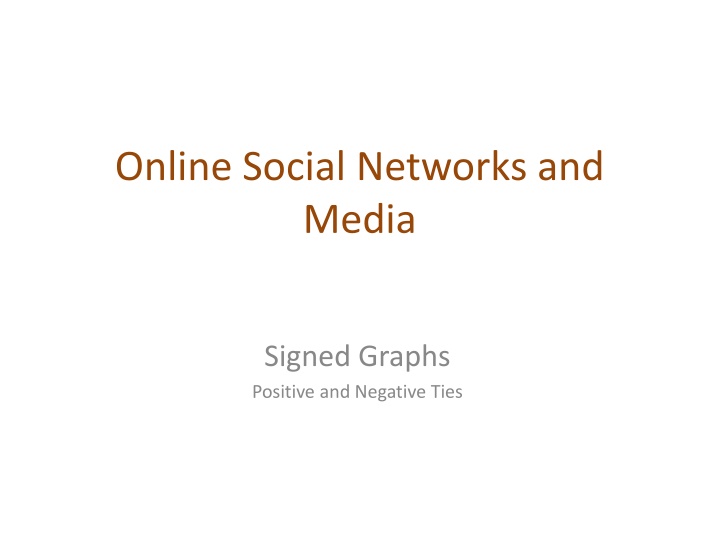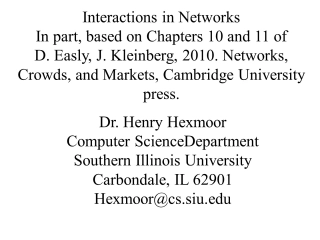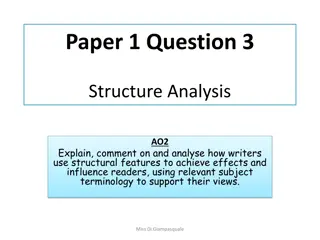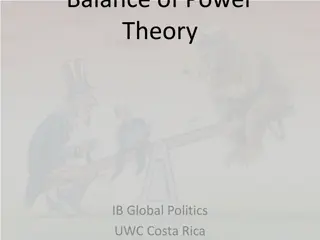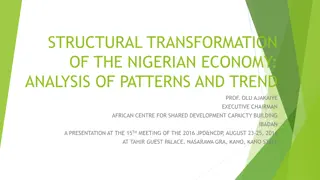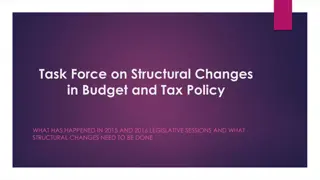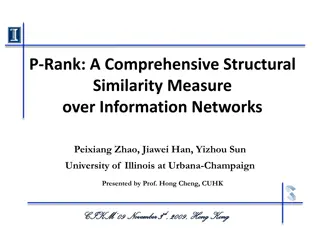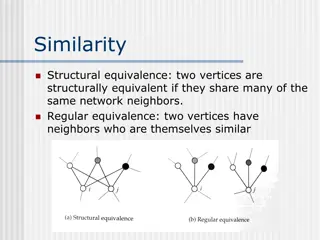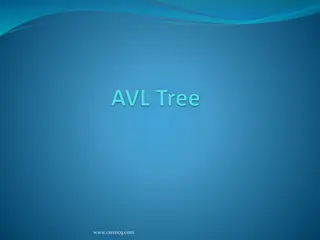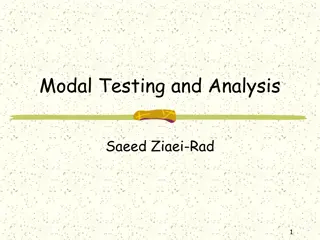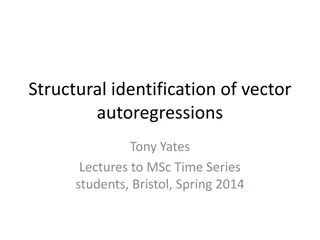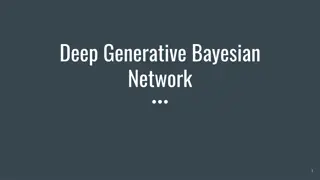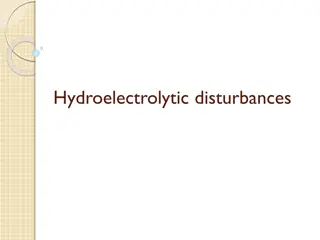Balanced Networks and Structural Balance Theory
In online social networks, relationships can be positive or negative, affecting the balance within a network. Structural Balance Theory, originating from social psychology, explores the dynamics of signed graphs and their implications on individual and group relationships. The theory delves into scenarios where mutual friendship and enmity can lead to stable or unstable network structures. Understanding the balance within networks is crucial for analyzing social interactions and network stability.
Download Presentation

Please find below an Image/Link to download the presentation.
The content on the website is provided AS IS for your information and personal use only. It may not be sold, licensed, or shared on other websites without obtaining consent from the author.If you encounter any issues during the download, it is possible that the publisher has removed the file from their server.
You are allowed to download the files provided on this website for personal or commercial use, subject to the condition that they are used lawfully. All files are the property of their respective owners.
The content on the website is provided AS IS for your information and personal use only. It may not be sold, licensed, or shared on other websites without obtaining consent from the author.
E N D
Presentation Transcript
Online Social Networks and Media Signed Graphs Positive and Negative Ties
Signed networks + - ? ? ? ? Negative foe Positive friendship Examples Sign expresses agreement/disagreement between users Trust/distrust relationships Edit conflicts in Wikipedia Relationships between countries Synonyms and antonym relation between words
Structural Balance Theory originated in social psychology, by Heider in the 1940s graph-theoretic approach by Cartwright and Harary in the 1960s Considers the possible ways in which triangles on three individuals can be signed All possible relationships between 3 people => 4 cases
Structural Balance 3 + 2 +, 1 - A is friend with B and C, but B and C do not get well together Mutual friends 1 +, 2 - 3 - Are there all equally possible? Mutual enemies A and B are friends with a mutual enemy
Structural Balance 3 + 2 +, 1 - Stable or balanced Unstable A is friend with B and C, but B and C do not get well together Implicit force to make B and C friends (- => +) or turn one of the + to - Mutual friends the friend of my friend is my friend 1 +, 2 - 3 - Stable or balanced Unstable Mutual enemies Forces to team up against the third (turn one of the to +) A and B are friends with a mutual enemy the enemy of my enemy is my friend
Structural Balance A labeled complete graph is balanced if every one of its triangles is balanced Structural Balance Property: For every set of three nodes, if we consider the three edges connecting them, either all three of these are labeled +, or else exactly one of them is labeled +, aka odd number of + local property, individual triangles What does a balanced network look like? (global property)
The Structure of Balanced Networks Balance Theorem: If a labeled complete graph is balanced, (a) all pairs of nodes are friends, or (b) the nodes can be divided into two groups ? and ?, such that every pair of nodes in ? like each other, every pair of nodes in ? like each other, and everyone in ? is the enemy of everyone in ?. From a local to a global property All - All + All +
Applications of Structural Balance How a network evolves over time Political science: International relationships Example: the separation of Bangladesh from Pakistan
A Weaker Form of Structural Balance Weak Structural Balance Property: There is no set of three nodes such that the edges among them consist of exactly two positive edges and one negative edge Unstable This is allowed
A Weaker Form of Structural Balance Weakly Balance Theorem: If a labeled complete graph is weakly balanced, its nodes can be divided into groups in such a way that every two nodes belonging to the same group are friends, and every two nodes belonging to different groups are enemies. From a local to a global property
Generalizations 1. Non-complete graphs 2. Instead of all triangles, most triangles, approximately divide the graph We shall use the original ( non-weak ) definition of structural balance
Structural Balance in Arbitrary Graphs Three possible relations Positive edge Negative edge Absence of an edge What is a good definition of balance in a non-complete graph?
Balance Definition for General Graphs 1. Based on triangles (local view) 2. Division of the network (global view)
Balance for General Graphs: local A (non-complete) graph is balanced if it can be completed by adding edges to form a signed complete graph that is balanced - +
Balance for General Graphs: global A (non-complete) graph is balanced if it possible to divide the nodes into two sets ? and ?, such that any edge with both ends inside ? or both ends inside ? is positive and any edge with one end in ? and one end in ? is negative The two definitions are equivalent: An arbitrary signed graph is balanced under the first definition, if and only if, it is balanced under the second definition
Balance Definition for General Graphs Algorithm for dividing the nodes?
Balance Characterization What prevents a network from being balanced? Start from a node and place nodes in ? or ? Every time we cross a negative edge, change the set Cycle with odd number of negative edges
Balance Definition for General Graphs Is there such a cycle with an odd number of -?
Balance Definition for General Graphs Is there such a cycle with an odd number of -?
Balance Characterization Claim: A signed graph is balanced, if and only if, it contains no cycles with an odd number of negative edges Proof by construction Find a balanced division: partition into sets X and Y, all edges inside X and Y positive, crossing edges negative Either succeeds or Stops with a cycle containing an odd number of - Two steps: 1. Convert the graph into a reduced one with only negative edges 2. Solve the problem in the reduced graph
Balance Characterization: Step 1 Find connected components of ? by considering only positive edges, let us call then supernodes Check: Do supernodes contain a negative edge between any pair of their nodes If Yes, ? is unbalanced Proof: say - between A and B, A and B connected by an all-positive path -> odd cycle
Balance Characterization: Step 1 Else: Reduce the problem: a node for each supernode, an edge between two supernodes if an edge in the original
Balance Characterization: Step 2 Note: Only negative edges among supernodes Start labeling each supernode by either ? and ? If successful, then label the nodes of the supernode correspondingly A cycle with an odd number, corresponds to a (possibly larger) odd cycle in the original
Balance Characterization: Step 2 Odd cycle Determining whether the graph is bipartite there is no edge between nodes in ? or ?, the only edges are from nodes in ? to nodes in ? Use Breadth-First-Search (BFS) Two type of edges: (1) between nodes in adjacent levels (2) between nodes in the same level If only type (1), alternate X and Y labels at each level If type (2), then odd cycle
Status theory in practice Epinions: product review Web site, where users can indicate their trust or distrust of the reviews Slashdot: the social network of the blog where a signed link indicates that one user likes or dislikes the comments Wikipedia: its voting network where a signed link indicates a positive or negative vote by one user on the promotion to admin status of another.
Structural balance theory in practice All-positive triad T3is heavily overrepresented in all three datasets. T3tends to be overrepresented by about 40% in all three datasets Triad T2consisting of two enemies with a common friend is heavily underrepresented. T2is underrepresented by about 75%in Epinions and Slashdot and 50% in Wikipedia More consistent with weak structural balance
A theory of status Directed networks A negative edge (A, B) means that A regards B as having lower status than A A positive edge (A, B) means that A regards B as having higher status than A A A - + B B A Assuming that all participants agree on status ordering, status theory predicts that when the direction of an edge is flipped, its sign should flip as well. - + B
A theory of status ? + A A + A B B - B + + + + + X X + X Structural balance - ? A A B B + + + + + X X
A theory of status: local property For any edge (?, ?), and any third node ?, possible to assign distinct numerical status values to ?, ?, and ? in such a way that the positive edges among them (if any) go from nodes of lower status to nodes of higher status, and the negative edges among them (if any) go from nodes of higher status to nodes of lower status. Three nodes u, v, and w are status-consistent if this condition holds.
A theory of status: global property Let ? be a signed, directed graph, and suppose that all sets of three nodes in ? are status-consistent. Then it possible to order the nodes of ? as ?1,?2,...,??in such a way that each positive edge (??,??) satisfies ? < ?, and each negative edge (??,??) satisfies ? > ?.
Summary Signed networks Two interpretations Friendship/Foe (undirected) Status (directed) Both at a local and global level
References Networks, Crowds, and Markets (Chapter 5)
Applications of Structural Balance The conflict of Bangladesh s separation from Pakistan in 1972 (1) - USSR N. Vietnam Pakistan USA - - - + Bangladesh - China India USA support to Pakistan? [T]he United States s somewhat surprising support of Pakistan ... becomes less surprising when one considers that the USSR was China s enemy, China was India s foe, and India had traditionally bad relations with Pakistan. Since the U.S. was at that time improving its relations with China, it supported the enemies of China s enemies. Further reverberations of this strange political constellation became inevitable: North Vietnam made friendly gestures toward India, Pakistan severed diplomatic relations with those countries of the Eastern Bloc which recognized Bangladesh, and China vetoed the acceptance of Bangladesh into the U.N.
Applications of Structural Balance International relationships (I) The conflict of Bangladesh s separation from Pakistan in 1972 (II) + - USSR N. Vietnam Pakistan USA - - + - Bangladesh - China India China?
Applications of Structural Balance International relationships (II)
